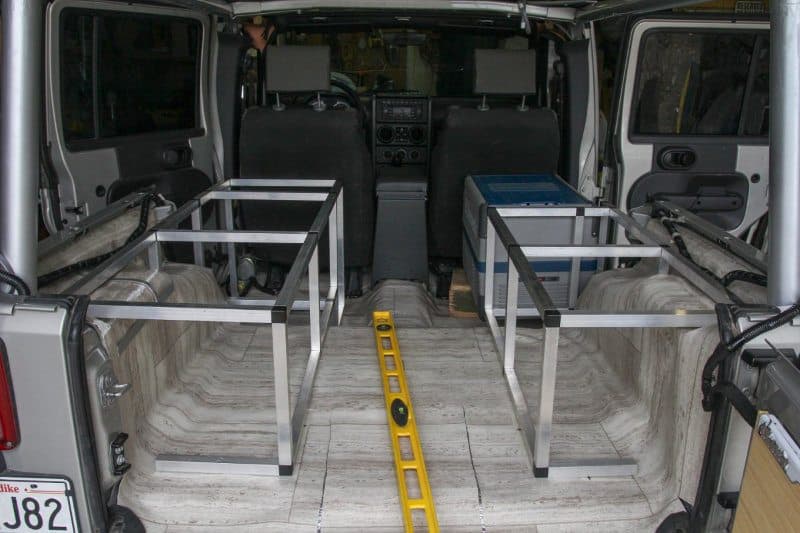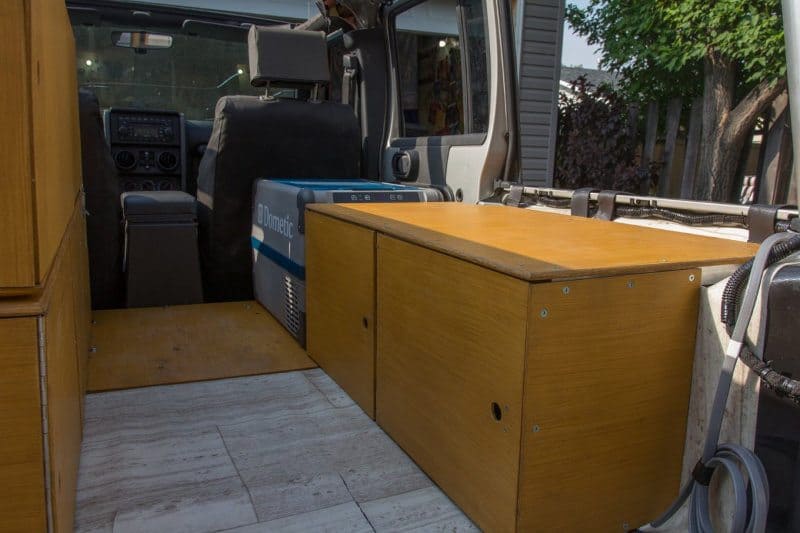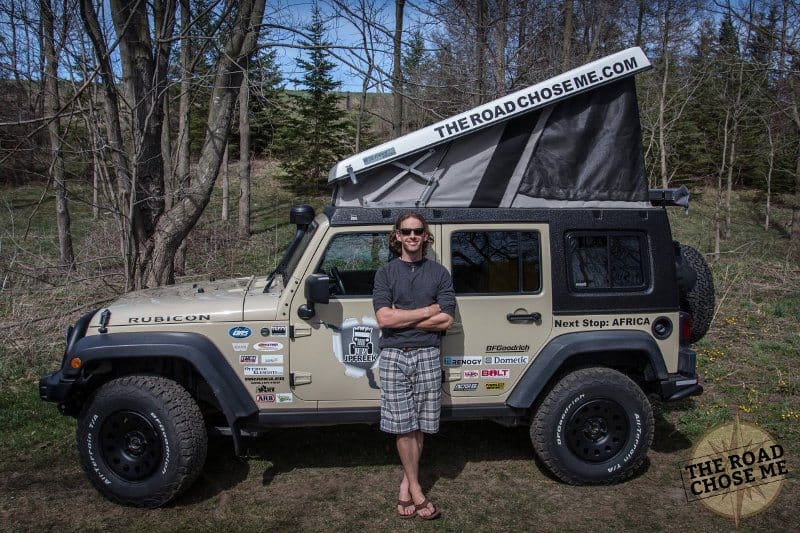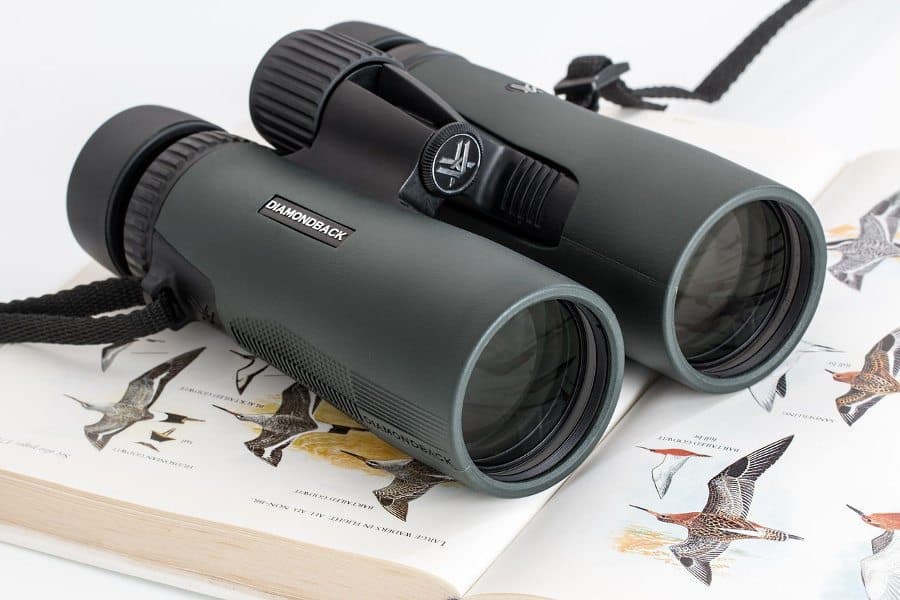Hi, I’m Dan.
A few years ago I drove a Jeep from Alaska to Argentina. I learned a lot on that trip about where I want to go and what kind of vehicle I want to live in.
After years of saving and planning, I bought a 2007 four-door Jeep Wrangler Unlimited Rubicon to turn into a house on wheels to drive around Africa for two years.
My build focused on interior living space and strong 4×4, and it had to fit inside a standard 20-foot shipping container.
Here’s what it was like…
NB: You can follow me on social media via the links below my bio, or visit me over at my website. I also wrote an e-book, “Work Less to Live Your Dreams.”
—
First, the finished project: my house on wheels completed.

The beginning: my new Jeep.

I started by stripping the entire interior. No backseat for me.

I had a plan to create a lot of interior living space, so the stock roll bar had to move. I was too timid to cut it myself, so that’s my buddy, who was all too happy to cut up my Jeep.

My friends and I made a new roll bar that’s much farther out of the way.

Dad and I designed this interior cabinet layout without having the Jeep in front of us. I built it exactly — mirrored — so the fridge is behind the passenger, not the driver. It doesn’t allow the seat to go all the way back, which I need to drive.

After lining the tub with dynamat and lino, I built cabinet frames out of aluminum tube and corner connectors. The whole setup was designed around a 35 L Dometic fridge mounted behind the front passenger seat.

I lined the cabinets with plywood — light and durable. I was too tired to take progress shots.

Another view. The ones up high on the left can un-clip and fit in the isle to make a flat sleeping platform when needed.

I was dead set on a diesel engine for my Jeep, so I paid to have a Mercedes 6-cylinder 3.0-liter turbo diesel installed.

It turned out to be massively more time, money, and effort than ever imagined … Then the engine blew up the week after I got it back. It sucked diesel from a leaking return line and ran away (Google it) pegging at 10k rpm + for 10 seconds or so. Melted pistons, valves, injectors, and glow plugs. It was scary as hell, and completely devastating. Years of planning and saving and then months of working on the Jeep down the drain. At this point I didn’t know what to do. I almost gave up.

After tons of soul searching, I decided this dream is worth going into debt for, so I sold the old Jeep and bought a replacement. It’s a 2011 Unlimited Rubicon, in my favorite color (tan).

This was a huge blow to my budget and plans. I will have to deal with it down the road when I run out of money — likely I’ll put a lot of the trip on credit now, and maybe stop for a year or more and work somewhere.
This one has a 3.8L gas engine, and 6-speed transmission. I’m leaving the entire drivetrain stock. A gas engine is not ideal for Africa, but so be it.
—
So my friend and I moved everything over from the silver one to the tan one in less than three weeks. We put a steel security center console in.

I moved the cabinets over, which fit basically the same.

I installed dual isolated Optima Yellow top batteries. This way the one that starts the engine is separate from the one running the fridge and everything else — so even if it goes dead, the engine will still start. The isolator joins them when the engine is running, so the alternator charges both.

I did a DIY how-to on the wiring that you can read here.
—
From Alaska to Argentina, I never saw a single sloth. I figure sloths and I would be friends, and they’re my power animal. So a friend made Sid for me, who hangs off the Jeep roll bar, always smiling.

I mounted an ARB air compressor under the hood so I can pump up my own flat tires. I had 16 flats from Alaska to Argentina.

We installed a heavy-duty rear bumper and swing-away carrier to hold the extra weight of the stuff I’m putting back there …

We installed a 2.5″ AEV suspension lift. Not so much for the lift, but more so because it’s beefier, and will handle the extra weight better.

We installed a Warn Zeon 10-S winch with synthetic line. It’s nice to know if I snap the line when I’m in the middle of nowhere by myself, the line won’t cut me in half.

I also installed an AEV front bumper that protects the radiator really well, and has a skid plate for the steering. Not pictured: I also installed an engine skid plate to protect it from rocks.

I’m expecting severe dust in Africa, so I installed a snorkel with dust pre-filter to remove dust before it goes down into the air cleaner. It’s more for dust than deep water, though that can’t hurt either.

I mounted a Titan Tank on the rear carrier, which is an extra 13 gallons of gas.

I designed and built a water storage, pump, and filtration system. It’s got an RV 12V pump and a 0.5 micron filter with a UV lamp built in.

Underneath, I moved the EVAP canister out of the way and then mounted a 12-gallon tank for drinking water.

Then I made a rock guard to protect it.

I wrote a massive DIY how-to on the whole water system that you can read here.
—
I had a pop-up roof installed by a company called Ursa Minor. This replaces the stock Jeep hard top, and pops open. Normally it’s a bolt-on to a stock Jeep, but my modified roll bar meant we could open it right up, so I can stand up and walk around in the back of the Jeep for massive interior living space.

With the upper sleeping slats removed, it’s wide open back there. I’m 6-foot-2 and have tons of head space.

When upstairs, this is the view down. There are wooden slats and mattress sections that slide into place to make the opening a flat sleeping platform.

This is during the building of the sleeping slats. They fold and slide out of the way on each side when I want standing room, or make a flat surface that the mattress section sits on when I want the upstairs sleeping platform.

On the rear carrier I’ve got the spare tire and 13-gallon gas tank, maxtraxx recovery mats (the orange things), a high lift jack, and a shovel to dig myself out.

We mounted an ARB awning on the back of the Jeep for a rain/sun shade. You can see it open in the first pic.

I mounted two 100-watt Renogy solar panels on the roof. These are extremely thin and lightweight panels.

They add virtually no wind resistance, and Ursa Minor made a tiny wind deflector for them.

The panels are wired into a charge controller that’s wired to the second battery. I left it for a week with the fridge running, and the battery was at 14.5V so the solar is easily keeping up with the fridge.

I bought a tailgate table with built-in cutting board, and then made a cutlery holder/organizer so all my often used stuff is easy to get at.

(I wrote a DIY article on exactly how I made the organizer that you can read here.)
—
I’m running BFGoodrich All Terrain KO2s, which should be the most versatile for all the varied conditions I’m expecting to encounter.

The wheels are steel and from Mopar. Steel is better for a trip like this because they won’t crack, and if they get damaged, I can beat them back into shape with a sledge hammer.

I’m extremely happy with how it’s come together. It’s just under 7 feet tall, and weighs 6,000 pounds with me and all my gear, food, clothes, tools and spares. It’s a few hundred pounds heavier than I would like, but it is what it is at this point.

As a trial I did a couple of weeks camping and off-roading around Moab, Utah. The popup has transformed the Jeep into something completely different.

I’ve put a map of Africa on the hood and I’ll be painting in my line as I move through the continent. It was a huge hit from Alaska to Argentina.

Given that you’ve read this far, I figure you are interested in what I’m doing. I’ll be updating my website and social media as I make my way around Africa. You can follow along at the links below my bio.

I’m also filming a YouTube channel this time, which I’m really excited about. I don’t want to just show what I’m doing. I want to show how I do it so you can live your dreams too! I’m working on a new video now, which is this build process in video/timelapse format.
Let me know if there is something specific you would like to see me photograph / film / visit along the way around Africa, or something specific about the Jeep.
I will film a “walkaround” showing off all the features as soon as it stops raining …
—
If you’re wondering how I pay for all of this, it’s all about priorities, and working hard to make your dreams come true.

You can read my thoughts on the matter here.
And I’ve written my first e-book — “Work Less to Live Your Dreams” — which teaches you exactly that.


